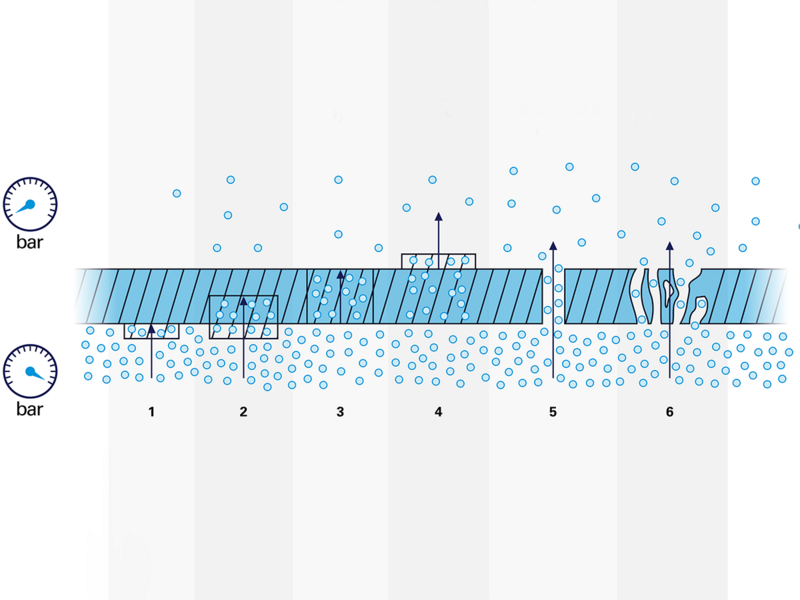
What Exactly Is Leakage? An Overview
Most of the time, leaks are a nuisance. This is true in the private sphere, with phenomena like dripping water faucets or flat bicycle tires, as well as in professional applications, where leaks can have negative effects like loss of performance or loss of valuable and/or hazardous fluids. When dealing with this problem, it is important to understand the theoretical implications of leakage and how to measure it.
Definition of Leakage
In everyday usage, the word “leakage” refers to a hole or a porosity in a surface through which a fluid inadvertently passes. However, this definition is not complete, as the definition in DIN EN ISO 20484, 2017 shows. Here, leakage is not limited to a hole or porosity, but also refers to a “[...] permeable element or other structure in the wall of an object capable of passing gas from one side of the wall to the other by the effect of pressure or concentration difference across the wall”.
Permeation – Leakage Without a Hole
While the concept of a hole or porosity is easy to understand, there is a more complex phenomenon that can also cause leakage called “permeation”. Permeation is a combination of adsorption, absorption, diffusion, and desorption:
- Adsorption describes the accumulation of gas or liquid particles at an interface between two phases. The adsorbed particles are then absorbed.
- Absorption means that particles enter a liquid or a solid increasing the concentration there. In the case of a pump leakage this is a solid like a metal or polymer part in which the particles enter.
- Diffusion occurs in order to equalize the differences in concentration. The difference in concentration could be due to absorption. Diffusion occurs in gases, liquids and solids.
- Finally, desorption occurs, which is the opposite of adsorption. During desorption, the gas or liquid particles separate from the solid or liquid phase and enter the gas or liquid. In a permeation leakage, desorption occurs on the opposite wall or phase side of the adsorption.
Among other factors, the permeation rate depends on the material that is being permeated, the wall thickness and the contact area. Therefore, measures to reduce permeation leakage may include optimizing the wall material used or increasing the wall thickness or reducing the contact area.

Quantifying Leakage Rates
The severity of a leakage is expressed by the term leakage rate. It quantifies the amount of mass transported through the wall, either through holes, porosity, or permeation. DIN EN ISO 20484, 2017 defines it as “pV throughput of a specific fluid which passes through a leak under specific conditions. Whereby the pV throughput is defined as the “[r]ate at which a volume of gas at specified pressure passes a given cross section of the system.” The pV throughput of the leak can also be understood as “lost” energy per time, or for example how long it would take to have a pressure drop of 1 mbar for a reservoir with a volume of 1 l. Thus, the leakage rate has the unit mbar l/s or Pa m³/s.
Leakage or No Leakage? Sometimes a Difficult Question
When measuring leakage, sometimes phenomena occur that produce the same readings as a leak but do not actually represent a leakage. These effects are called “virtual leaks”. They are apparent leaks that are caused by sorbed or occluded gases within the system’s materials. Sorption is the umbrella term for adsorption and absorption. Occlusion is the trapping of undissolved gas in a solid during solidification. Thus, a wall or phase can act as a leak, but the mass is not actually transported across the wall or phase boundary but remains on or in the wall or phase and is later released on the same side from which it came.
Get in touch to learn more about how KNF can help you understand and reduce leakage!
75 Years: KNF Celebrates Company Anniversary
A treasure chest filled with memories, facts and stories. Learn more about KNF’s company history.

